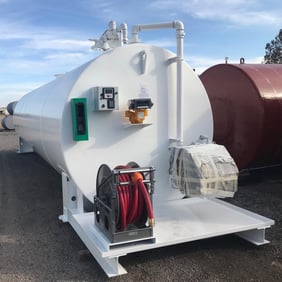Hydrogen Peroxide Storage
What is Hydrogen Peroxide?
Hydrogen peroxide, with the chemical formula H₂O₂, is a colorless liquid with a slightly sharp odor, slightly thicker than water, and available in concentrations ranging from 3% to 90%. Its higher concentrations can cause skin irritation due to its strong oxidizing properties. It serves various purposes such as an antiseptic, rocket fuel, and a reactant in the production of chemicals like polyethylene terephthalate (PET) and propylene oxide.

Where Can I Store It?
- Stainless Steel Storage Tank
- When it comes to storing high-purity, concentrated hydrogen peroxide solutions in the range of 10% to 90%, stainless steel tanks are the undisputed champions due to their exceptional resistance to corrosion and compatibility with this powerful oxidant.
- Polyethylene containers (HDPE), Glass containers stores the chemical concentration of 10%
- Polyethylene containers (HDPE), Glass containers with Teflon liners stores the chemical concentration of 30%
- Glass containers with Teflon liners stores the chemical concentration of 50% to 90%
- 3% - 5% concentrations can be stored in secure, well-ventilated areas within facilities, like dedicated storage rooms or laboratories.
- 10% - 30% high concentrations require dedicated, well-ventilated storage rooms with fire suppression systems and secondary containment measures.
- 35% - 90% highly concentrated solutions need specially designed storage buildings or warehouses with robust safety features and compliance with strict regulations.
- Lifespan will vary based on the tank construction, maintenance, and environmental conditions. On average, the lifespan generally falls between 25-30 years but with proper care and maintenance, it lasts 50 years or more.
- When it comes to storing high-purity, concentrated hydrogen peroxide solutions in the range of 10% to 90%, stainless steel tanks are the undisputed champions due to their exceptional resistance to corrosion and compatibility with this powerful oxidant.
- HDPE (High-Density Polyethylene)
- Generally safer and more reliable option than LDPE
- The most common solution for storing hydrogen peroxide from 10% - 30%.
- Offer excellent resistance to corrosion from hydrogen peroxide, even at the highest concentration (90%)
- LDPE (Low-Density Polyethylene)
- Not generally recommended for LDPE, as it can start showing signs of degradation even at lower concentrations (around 10%)
- The degradation can lead to leaks, container failure, and potential contamination.
*Please be aware that hydrogen peroxide is highly corrosive and can cause severe burns and tissue damage. Handle with care!
Secondary Containment Options
Secondary containment is required for all hydrogen peroxide tank systems. Engineering safety protocols recommend that secondary containment contains at least 110% of the total system volume. So, if you are storing 100 Gallons of hydrogen peroxide you would need at least 110 Gallons of secondary containment for hydrogen peroxide. A common method of providing secondary containment for hydrogen peroxide is to erect a concrete dike around the tank with an acid resistant coating. Other common methods are using containment basins, sumps, and double walled tanks. All Secondary containment options should adhere to local regulations and code. One Clarion provides a wide selection of secondary containment options.

Let's Connect
Fill out the form below and we will get back with you within 24 hours. For immediate assistance, call: 772-932-5923 during normal business hours. We offer quick lead-times, and ship across the US and internationally. Fast, affordable shipping from warehouses nationwide.
